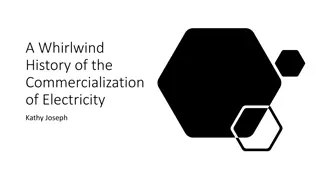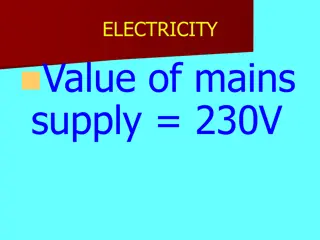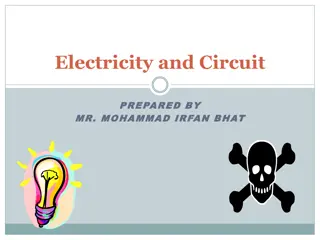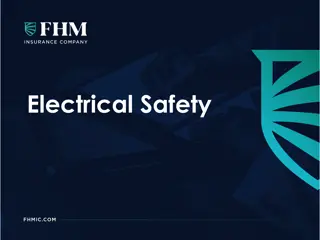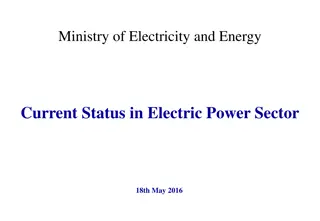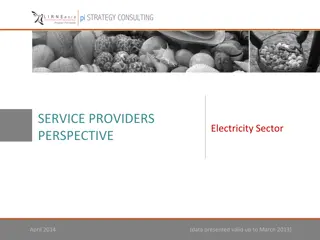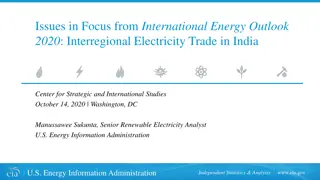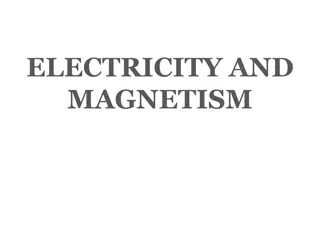
Electricity at Work Regulations Overview
Understanding the Electricity at Work Act 1989 is crucial for preventing electrical hazards in the workplace. This act aims to safeguard individuals from death or injury caused by electrical sources during work activities. It outlines regulations that employers, self-employed individuals, and employees must adhere to in ensuring electrical safety. Learn about the key provisions and responsibilities under the Electricity at Work Act 1989.
Download Presentation

Please find below an Image/Link to download the presentation.
The content on the website is provided AS IS for your information and personal use only. It may not be sold, licensed, or shared on other websites without obtaining consent from the author. If you encounter any issues during the download, it is possible that the publisher has removed the file from their server.
You are allowed to download the files provided on this website for personal or commercial use, subject to the condition that they are used lawfully. All files are the property of their respective owners.
The content on the website is provided AS IS for your information and personal use only. It may not be sold, licensed, or shared on other websites without obtaining consent from the author.
E N D
Presentation Transcript
Peter McCann Health & Safety Advisor AndersonMaguire
Electricity At Work Act 1989
E.W.A Background: Electricity is a major hazard as not only can it cause direct injury through shocks, it also can be the source of indirect injury through causing explosions etc. Consequently it poses a major health and safety risk for anyone involved with electricity during the course of their employment.
E.W.A The aim of the Electricity at Work Regulations 1989 is to prevent death or personal injury to any person from electrical causes in connection with work activities. The following people are subject to the regulations: employers and the self employed; employees. Every employer, self-employed person and employee has a duty to comply with these regulations in so far as they relate to matters within their control. Employees must also co-operate with their employer as much as is necessary to enable any duty placed on the employer by the regulations to be complied with. Electrical equipment under the regulations includes anything used, intended to be used or installed for use, to generate, provide, transmit, transform, rectify, convert, conduct, distribute, control, store, measure or use electrical energy.
E.W.A The Electricity at Work Act 1989, consists of the following; PART II GENERAL 4.Systems, work activities and protective equipment 5.Strength and capability of electrical equipment 6.Adverse or hazardous environments 7.Insulation, protection and placing of conductors 8.Earthing or other suitable precautions 9.Integrity of referenced conductors 10.Connections 11.Means for protecting from excess of current 12.Means for cutting off the supply and for isolation 13.Precautions for work on equipment made dead 14.Work on or near live conductors 15.Working space, access and lighting 16.Persons to be competent to prevent danger and injury PART I INTRODUCTION 1.Citation and commencement 2.Interpretation 3.Persons on whom duties are imposed by these Regulations
E.W.A PART III REGULATIONS APPLYING TO MINES ONLY 17.Provisions applying to mines only 18.Introduction of electrical equipment 19.Restriction of equipment in certain zones below ground 20.Cutting off electricity or making safe where firedamp is found either below ground or at the surface 21.Approval of certain equipment for use in safety-lamp mines 22.Means of cutting off electricity to circuits below ground 23.Oil-filled equipment 24.Records and information 25.Electric shock notices 26.Introduction of battery-powered locomotives and vehicles into safety-lamp mines 27.Storage, charging and transfer of electrical storage batteries 28.Disapplication of section 157 of the Mines and Quarries Act 1954 PART IV MISCELLANEOUS AND GENERAL 29.Defence 30.Exemption certificates 31.Extension outside Great Britain 32.Disapplication of duties 33.Revocations and modifications
E.W.A General safety of electrical systems Regulation 4 requires that all electrical systems, so far as is reasonably practicable, be of safe construction and maintained in that state to prevent danger. Work carried out on or near a system, including both the operation of the system and the maintenance of the system, shall be carried out in such a manner as not to give rise, so far is reasonably practicable to danger. Any equipment which is provided to protect those at work on or near electrical equipment shall be suitable for this purpose and maintained in a condition to ensure it is properly used. Strength and capability of electrical equipment Regulation 5, no electrical equipment shall be put into use where its strength and capability may be exceeded in such a way as may give rise to danger.
E.W.A Adverse or hazardous environments Regulation 6 states that electrical equipment that may reasonably be foreseeable to be exposed to the following dangers must be constructed in such a way to protect or prevent so far as is reasonably practicable danger arising from such exposure: mechanical danger; the effects of weather, natural hazards, temperatures or pressure; the effects or wet, dirty, dusty or corrosive conditions; any flammable or explosive substance including dusts, vapours or gases. Insulation, protection and placing of conductors Regulation 7 requires that all conductors in a system that may give rise to danger shall either: be suitably covered with insulating material; have such precautions taken in respect of them as will prevent danger so far is reasonably practicable.
E.W.A Earthing, integrity and connections Regulation 8 specifies a requirement for suitable methods of earthing. Regulation 9 requires that earthing conductors must not have their electrical continuity broken by anything that could give rise to danger. Regulation 10 specifies a requirement that all joints and connections must be suitable for safe use. Regulation 11 requires that efficient means shall be provided for protecting from excess of current every part of a system as may be necessary to prevent danger. Isolation and cutting of supply Regulation 12 states that where necessary to prevent danger, the supply must be cut off or isolated. Isolation means the disconnection and separation of electrical equipment from every source of electrical energy in such a way that disconnection and separation is secure. Precautions for work on equipment made dead Regulation 13 requires suitable precautions to be taken to ensure that once equipment is isolated so that work can be carried out on it, it cannot become electrically charged again while the work is being carried out on it. An example of this is disconnecting a fuse box to enable work to be done on the electrical cabling. In these circumstances, adequate precautions will not be taken if the fuse is simply disconnected and left hanging next to the box someone could easily re-insert the fuse not knowing the reason for the disconnection, thus making the system live again.
E.W.A Work on or near live conductors Regulation 14 states that no-one shall be work on or so near any live conductor that danger may arise unless: it is unreasonable in all the circumstances for it to be dead; and it is reasonable in the circumstances for work to be done on it or near it when it was live; and suitable precautions are taken to prevent injury. Access, space and light Regulation 15 requires that there be adequate working space, safe access and adequate lighting to enable work on electrical equipment to be carried out safely. Competent persons Regulation 16 specifies that anyone working on electrical systems where technical knowledge or experience is necessary to prevent danger must have the required knowledge and/or experience or be under suitable supervision.
E.W.A Portable appliance testing: Portable appliance testing (commonly known as "PAT", "PAT inspection" or (redundantly) as "PAT testing") is the name of a process in the United Kingdom, the Republic of Ireland, New Zealand and Australia by which electrical appliances are routinely checked for safety. Claims that PAT testing is required by law and that the client is breaking the law by not having it done are simply not true. The law does require however that employers, including self-employed, ensure that all electrical equipment that they provide in their business is safe and properly maintained. The UK Health and Safety Executive along with insurance companies will expect you to perform PAT testing to ensure that you are compliant with certain regulations including: Health and Safety at Work Act of 1974 The Electricity at Work Regulations of 1989 The Provision and Use of Work Equipment Regulations of 1998 The Management of Health and Safety at Work Regulations of 1999 Although there are no requirements for PAT testing frequency, there are recommendations: Offices, Shops and Hotels Class 1 equipment including stationary and IT equipment should be tested every 48 months. Moveable equipment such as extension leads and portable equipment should be tested every 24 months.
RIDDOR Any Questions ?







